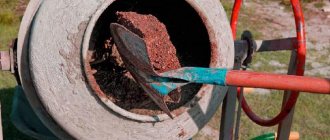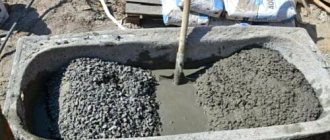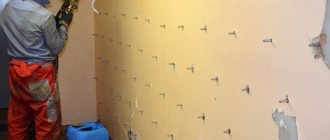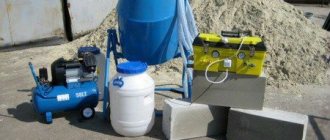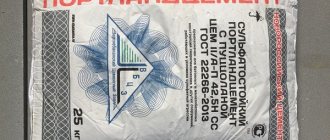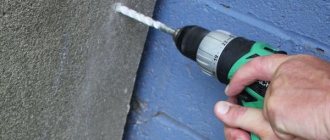How to drill concrete: tools, preparation, process technology
The need to hang a chandelier, install wall cabinets, a socket, etc., sooner or later arises in the life of every owner of a living space.
Considering that concrete columns, floors and ceilings are quite common in modern apartments, it may turn out that the fasteners have to be mounted on a concrete structure. If you are “lucky”, then it is quite natural to wonder how to drill concrete? Concrete is one of the most durable building materials today. However, its strength in this case is the main problem, since it is not possible to drill reinforced concrete without specialized equipment and relevant knowledge. At the same time, calling specialists to form several small-sized holes will cost you a disproportionately large amount.
Drilling a wall with a hammer drill: photo
If you want to save money, then it would be quite reasonable to think about solving this problem yourself. Despite the obvious complexity, the right approach and strict adherence to the technological part of the process will help you achieve a high-quality result. This article will provide you with detailed instructions on how to drill concrete with your own hands.
While drilling you hit the reinforcement
Reinforcement is an iron rod that runs inside the concrete and makes the wall structure much stronger. If during the drilling process you feel that the drill does not go any further, and instead of the usual sound there is a metallic clang, it means that you have hit the reinforcement. There is no need to continue trying to drill through the reinforcement with the same drill - you won’t succeed, and you will break the concrete drill. There are 2 options here:
You can drill a hole nearby
If it is not important to make a hole in the exact place you are drilling, just make a hole nearby in a different place. The main thing is not to hit the reinforcement again. In this case, you will need to look for the place a third time. I would like to reassure you right away that getting into reinforcement is not a common occurrence. This is an exception rather than a permanent rule.
You can't drill nearby. Only needed in this place
If it is important to drill holes in concrete here and only here, then in this case you need to change the drill. You drilled with a drill on concrete, but you need to install a drill on metal. Next, you carefully drill through the reinforcement with a metal drill, and then install the concrete drill again and continue working.
This way you can pass right through the reinforcement. Just keep in mind that the drill for metal must be exactly the same diameter as the drill for concrete and must be sharpened (not blunt), otherwise you will be drilling this piece of iron for a very long time.
And yet, you need to understand what kind of power tool you work with. If you do everything with an impact drill, then when changing the drill to a drill for metal, do not forget to change the chiselling mode to the drilling mode and vice versa; when installing a drill for concrete, set the chiselling mode again. If you hammer with a hammer drill and drill with a drill, then simply change these tools depending on what you are doing.
You can read the operating modes of an impact drill in detail by downloading my book: My Impact Drill. 5 tools in one.
Drilling recommendations
The drill should not be allowed to overheat; work should be interrupted every 16 seconds; the tool should cool naturally, without any liquid.
If stones hit during operation, it is difficult for this element to move further; the stone must be broken using a chipper, then work continues. When drilling a hole in a load-bearing wall or ceiling, it is recommended to use a hammer drill; with its help, the work can be completed as quickly and efficiently as possible.
It is also better to drill a reinforced concrete wall with a hammer drill. For a hole in ceramics on the wall, you cannot use the impact method or use a drill on concrete, otherwise the tile will collapse.
Cheap models can be sharpened from time to time using an angle grinder with a diamond blade mounted on it.
Practical advice from experts
It is important to use tools and equipment correctly. A set of drills with different performance characteristics is prepared. Concrete walls are lined with wood, tiles, and stone, for which you will need different drills. Before work, make sure that there is no wiring under the plaster at the drilling site.
Before drilling, pay attention to important points:
- for holes deeper than 10 cm and with a diameter greater than 12 mm, use a hammer drill;
- work begins at reduced speed, the impact function is turned on when the rod deepens by 5 mm;
- holes for dowels are drilled 10 mm longer than the plastic body.
If the drill bit gets stuck while going deeper, it is removed and the hole is drilled with a punch to break the encountered stone and move further.
Diamond drills are more expensive than pobedit drills and are used only without the inclusion of an impact mechanism. They need to be cooled every 10 minutes; this must be done without water, only in air.
Main types of concrete drills
A distinctive feature of a concrete drill from others is soldering. It is created from a strong alloy, due to which a hardness similar to diamond stones is achieved. Craftsmen call these types pobedit; these products differ in strength from other types that are created for metal or wood.
There are 2 main types by which concrete drills are classified:
- for a drill - consist of a shank for a nozzle, which is made in a cylindrical or multifaceted shape. The dimensions are small, the product is suitable for creating holes in many hard materials, for example, brick, foam block. It is recommended to use a high-power drill, which will allow you to drill into concrete,
- for a hammer drill - the drill is cylindrical in shape, has a shank, designations SDS PLUS or SDS MAX. The goods themselves are quite large and long, suitable for reinforced concrete structures.
If you need to create holes in a reinforced concrete structure using a simple drill, then it is not always possible to solve the problem with just a drill. You need to use a hammer drill, and for this tool, drills are divided into the following types:
- screw - used to create deep holes,
- spiral - suitable for large holes,
- flat - used for drilling passages of different sizes and depths.
For proper operation, you will need to not just insert the drill into the chuck, but snap it into place. To make this task easier, the products have a slight thickening at the very end. It should also be noted that the products are considered professional tools, since they can be used to create holes from 4 mm to 3 cm in diameter.
If you need a larger hole, then the crown type will come to the rescue. Such products make it possible to make a recess of 12 cm in diameter. The products are very durable and are produced in several versions:
- diamond - visually made in the form of a pipe or crown, mounted on a rod, the edges are coated with diamond, which ensures high strength,
- pobedit - similar to an attachment, the main difference from diamond is the absence of sputtering; it is replaced by special teeth made from pobedit.
It is recommended to use crown products for holes for sockets, switches or wiring, and other communications. To select a suitable concrete product for a drill, you will need to take into account not only the parameters of the element, but also the dimensions of the future hole. Based on this, the length of the drill is selected, which depends on the diameter:
- diameter 4 mm - length 5 cm,
- 5 mm - 10 cm,
- 6 mm - 15 cm,
- 8 mm - 25 cm,
- 10 mm - 54 cm,
- 12 mm or more - up to 100 cm.
It turns out that for large holes a long concrete drill is used. If you use thin instruments, there is a risk of damage due to increased load.
Preparatory stage
Before carrying out construction work, the premises or room should be completely cleared of items of material value and furniture. So that nothing lies under your feet and interferes with your work. Before starting work, as befits, we take all the necessary measurements with a tape measure, then place marks (it is advisable to make notches on the concrete). Then, with a simple hand movement, snap the crown onto the instrument.
Is it possible to sharpen a Victory bit?
When dull, a drill bit with pobedit tip can be sharpened. The sharpening angle depends on the hardness of the material that needs to be drilled. For the hardest material, the smallest possible angle should be provided. The sharpening process must be done carefully so as not to destroy or overheat the pobedit soldering. To do this, you can cool it.
Typically, a drill with a Pobedit tip has a diameter of 3 millimeters. The maximum diameter of drills for hand tools is 12 millimeters, but can be larger.
The length of the drill ranges from 70 to 200 millimeters and increases with increasing diameter.
Drilling technology
When analyzing the topic of how to drill a concrete wall with a conventional drill, you should understand that for successful drilling you need to take into account certain nuances:
- If you need to get a deep hole with a large diameter, it is better to drill it with a hybrid drill and hammer drill.
- When making a hole for a dowel, you need to drill to a depth exceeding the fastening element. Then this reserve will become clogged with dust when driving the dowel.
- It is recommended to start drilling without turning on the impact mode, setting the tool to medium speed. After deepening the drill, the speed is sharply increased, while simultaneously adding the striker mode. By doing this, you eliminate the possibility of the drill moving due to vibration.
- When working, a lot of dust invariably appears. It is advisable to turn on the vacuum cleaner, then the flying particles will be sucked up by it.
- When clamping the drill, you need to insert its shank all the way.
- A low-power drill is used for no longer than a quarter of an hour. Then take a ten-minute break.
- If you wet the bit before drilling, the wear on its cutting tip will be reduced.
- If a through hole is being made, reducing the speed at the final stage will help prevent concrete from spalling on the opposite side.
When the drill is jammed in the monolith, you cannot remove it by hitting it with a hammer or trying to loosen it with pliers. You can remove the stuck part by drilling a small hole nearby.
The procedure is successfully completed when the final goal is achieved, the instrument remains undamaged.
Features and types of concrete drills
Different types and sizes of drills
A high-quality reinforced concrete drill should be so hard and durable that it can make a good installation hole the first time and not break. The production of such elements is made from especially strong steels, with diamond coating or pobedite surfacing. It is this additional processing that distinguishes concrete drills from all others by their extreme strength and hardness.
In appearance they are quite similar. A diamond drill resembles a crown on a base rod with a fine diamond coating. The Pobedit one is quite similar in design to the diamond one, but it is made in the form of an attachment and instead of sputtering there is Pobedit overlay at the very tip. It is she who crumbles the concrete.
Concrete drill set
The first sign by which all available drills can be divided is their purpose. There are breakout attachments that do not make a neat hole, but simply remove concrete for installation of other structures. Through-hole drills are used specifically to create holes of various diameters and depths.
- In addition to the main classification of drills, they can also be divided into two large groups according to the tool: for drills and hammer drills.
- They differ slightly in design, namely in the shape of the shank. Thus, the drill attachment is equipped with a cylindrical shank, while the hammer drill attachment has a hexagonal shank. Less often a cylinder.
- Also, the latter must be marked SDS PLUS or SDS MAX. A concrete drill bit for a hammer drill, or also called a drill, is shown in the photo below.
Drill bit for concrete
If you have no experience, which drill to use in concrete in a specific situation, you can decide after the first drilling test. Roughly speaking, if the drill does not take concrete, then you need to take out a hammer drill and use it, since just such a drill is capable of making a hole even in the densest material.
Concrete drills can be divided into three large groups, intended for specific work:
- Flat drills provide the opportunity to make holes of small diameter and length. But such drills require more effort to operate.
- Spiral drills allow you to create large diameter mounting holes. They are large in size and have an elongated shape.
- Auger drills are the professionals for drilling deep holes. For example, to create a long hole, but no more than 1 meter, you need to take a 12 meter drill. There are grooves for removing construction dust.
Large-size drill in a hammer drill
Attention! But there are also special attachments - for example, a drill for aerated concrete. It differs in shape and parameters from pobeditovy and diamond, which do not drill, but simply destroy cellular concrete. It has a hexagonal rod shape, and at the end there is a special design that carefully makes the necessary installation holes in the aerated concrete.
Drill for aerated concrete
But, knowing this information, it is impossible to select the right drill with complete confidence. You also need to take into account its parameters, which directly determine the size of the future mounting hole.
The video in this article will tell you more clearly how to distinguish drills from each other.
Basic criteria for choosing a drill for concrete
Drills of various diameters and lengths
Before you buy drills, you need to decide on the volume and type of work to be performed. And accordingly, purchase the necessary tool. After all, their price is not the lowest among the entire range of similar drilling devices.
For small home repairs, a diamond drill with a small diameter ranging from 6 mm to 10 mm will be sufficient. If you just need to hang a picture, then take a closer look at thinner drills with a diameter of 3 mm, 5 mm, and 5.5 mm.
Depending on the diameter of the drill, mounting holes of varying depths are obtained:
- d=4 mm – L=50 mm;
- d=5 mm – L=100 mm;
- d=5, 5– L=100 mm;
- d=6 mm – L=150 mm;
- d=8 mm – L=250 mm;
- d=10 mm – L=540 mm;
- d=12 mm, 16 mm, 18 mm, 20 mm, 250 mm and other sizes - L up to 1000 mm.
Multi-format drill bits for concrete
According to the main GOSTs, drills have modern markings, which indicate their sizes, and not just the diameter. Below are the most common drill length parameters for performing various tasks.
They will help you decide which drill to choose for concrete in a particular situation:
- Drill 6x110 - indispensable when carrying out repairs in apartments and houses for various purposes. This type of drill is the most common. For this reason, it cannot always be found on the shelves of specialized stores.
- The 8x600 drill bit is also suitable for making deep holes. If you do the sharpening correctly, you will completely answer your question: “Is it possible to drill wood with a concrete drill?” Of course, it won’t be very convenient to drill into wood with a heavy-duty drill bit into concrete, but if you get the hang of it and acquire a certain skill, it will work out well.
- Drills 12x200 and 12x460 are intended for installation of various furniture and installation of electrical cables of any complexity.
- Drill 24x460 is a large-sized drill, actively used in the construction of heating and water supply systems.
Gradation checked by length
These are the main criteria when choosing drills. But they differ in quality and have their own characteristics. Therefore, special attention should be paid to the manufacturer. It is he who will tell you how to choose a drill or drill of the required size and configuration.
Which drill brand do you prefer?
Bosch drill set
Let's go over the main, all well-known brands that produce drills.
These are the ones you can see on the shelves of almost all specialized departments and stores:
- B osch is the most popular brand, under whose logo you can find drills on the shelves. They are distinguished by a four-spiral shape of the working rod, which helps to apply a minimum of force and remove dust and crumbs along with the drill from the hole. They are also distinguished by increased performance and minimal friction. Drills are most suitable for making deep holes in concrete of any density.
- Diager Twister is a reliable manufacturer that has proven itself in the market with high-quality and reliable products. Drills are applicable not only for concrete, but also for brick and natural stone of any hardness. From the wide range of this brand you can choose an impact drill of any size.
- Makita has focused its attention on producing highly accurate drill bits with unique brazing. Such devices can be used with concrete to make shallow and ultra-precise holes.
- BISON is the most famous domestic brand, under which various types of drills are produced. They are no less reliable than the above products, but are more affordable.
The set was verified by Bison
If we look at Chinese manufacturers, then among them you can also find decent examples of drills. But the price for them will not differ much from the cost of Bosch or Makita. More budget options may be fake, which you will immediately find out when drilling.
It is quite difficult to determine by eye what a factory original looks like and how it differs from a fake. Therefore, in the question of which drill to choose is best and not to make a mistake, consult the seller.
Selecting a drilling tool
Hammer drill
The potential of this tool when making holes in a concrete surface has no limits. Often they are limited by the maximum permissible diameter of the device, the size of which is no more than 5 centimeters. And at the same time, a huge part of such equipment can drill a hole with a diameter of 3 centimeters. Sometimes this may be enough, but there are situations when this size is not enough. For example, the volume of the hole for ventilation is supposed to be large and in such a situation the hammer drill will not cope with the task.
When operating a hammer drill with your own hands, another problem may arise. While drilling, you may bump into the reinforcement with the drill. This may result in damage to the tool. In the best case scenario, the hammer drill will stop on the metal and will no longer be able to work. It becomes clear that in the presence of reinforcement in concrete, operating a hammer drill is difficult, and sometimes impossible. But if working conditions do not require the presence of reinforcing bars, then this tool is an excellent choice.
Carbide bit
This equipment is distinguished by drilling holes with a diameter of 5 centimeters to 45 centimeters.
But alas, the characteristics of a conventional hammer drill do not make it possible to install a crown larger than 25 centimeters. The reason for this is that the power rating of the tool is too low. If it is necessary to make holes of large calibers, then it is worth using a different tool. Larger equipment has a different shank shape. However, there are special adapters that make it possible to use large crowns on low-power instruments. But it is worth remembering that this option is not always profitable and safe due to the fact that the equipment may be damaged due to the installation of a large crown. And drilling holes in concrete using the thin method can be dangerous.
This device has some disadvantages that limit the capabilities of such equipment:
- Cannot drill through reinforcement. During a collision with metal, the carbide crown is destroyed. And while thin metal can be drilled, thick reinforcement cannot be drilled.
- If a crown is used, the concrete can be drilled to a small depth. This indicator is limited to the bowl. However, there are situations when using this device you can drill holes in a fairly thick wall and pipe.
The point of drilling a hole with a hole saw is to use the bit and pick one at a time. When the depth required for the crown has been reached, it is necessary to hollow out the center in the hole using a pick, after which the procedure is repeated until the necessary is completed.
However, in this case, another problem arises - the limited immersion depth of the lance. This nuance can be eliminated if a special extension for the crown is installed correctly. It is important to know that when performing such operations with concrete there will be a lot of dust around.
Design features of a drill with pobedit
A pobedite drill does not differ significantly in appearance from a standard twist drill. It also consists of a shank, a working part and a cutting edge and has a cylindrical shape. The shank can be cylindrical, hexagonal, or have an SDS profile if it needs to be installed in a hammer drill. The working part of the drill is made of tool steel and has a number of helical grooves on the surface designed to remove chips from the drilling zone. But the drill tip is made of hard alloy - pobeda.
Drills with a Pobedit tip do not require pre-sharpening immediately after purchase. They are ready for use, and their cutting profile angle is 130 degrees. The pobedite tip usually has a flat shape. Its width is identical to the diameter of the hole that needs to be made in the workpiece. This tip is fused to the working part of the tool. The tip of the drill is the center of the tip. The tip divides it strictly into two equal parts. If they are not equal, then such a tool will not work.
Concrete cutting tool
The formation of holes in concrete structures is carried out using a specialized cutting tool:
- concrete drill;
- drill;
- crown
Drill
A drill is a cutting device for making holes.
- cylindrical shank;
- working part with spiral grooves for chip removal;
- cutting part.
The specificity of the drill for concrete is the presence of carbide brazing. The strength properties of the latter allow it to withstand impact loads that destroy concrete.
The insert looks like a small rectangular plate placed across the cylindrical end of the tool.
The maximum diameter obtained with a Pobedit drill for concrete does not exceed 12 mm. Minimum – 4 mm. Drilling depth limited to 30
Borax (species)
The difference between a drill and a drill is the method of attachment.
The tool has a shank made using the SDS (SDS+) fixation system, etc. The spiral grooves are smaller and spaced at smaller pitches. For production, special hardened tool steel is used. The drill is equipped with a two- or four-sided cutting plate. The maximum diameter of the hole formed by the drill reaches 40 mm. Depth – up to 800
Types of concrete drills:
- pass-through – drilling holes of various diameters;
- flat – used to form a shallow hole;
- spiral - for deep passages;
- screw, – deep drilling, the presence of spiral grooves for removing sludge;
- breaking – used for operations with dimensional products.
A subtype of drill is a crown for concrete.
Crown
It is a tubular product:
- removable or monolithic shank with a fixation system in the hammer drill;
- pilot drill;
- a working cylinder that determines the diameter of the hole being made;
- carbide brazing on the end part, a type of diamond coating.
Using a concrete crown can be used to:
- a hole in the concrete for an outlet;
- under the pipe;
- bundle of cables, etc.
Types of concrete drills for rotary hammers
They differ in some important parameters, which are discussed in detail below.
Shank size
There are 5 types:
- SDS - shank with a diameter of up to 10 mm with two grooves.
- SDS plus is the most common size used in household hammer drills. It is characterized by a diameter of no more than 25 mm. There are four grooves for fixing it.
- SDS-max - shank with a diameter of up to 80 mm, used in industrial units. For fixation, it uses three open and two closed grooves.
- SDS-top is an intermediate shank size with a diameter of 16-25 mm, used in some BOSCH power tools. It has 4 grooves for good fixation.
- SDS-quick is a hex shank with a diameter of 4-10 mm, designed for Bosch Uneo/Uneo Maxx rotary hammers. It uses dowels for fixation.
Diameter and length
These are the most important dimensions of the drill, so you should definitely pay attention to them during selection and purchase.
- Diameter. Depends on the length and type of shank - for example, the maximum permissible hole Ø SDS max is no more than 50 mm. It is expressed as an even number.
- Length. The maximum drill length for a rotary hammer is 1000 mm, and the minimum is 100 mm. In production, the most popular drills are Ø 18, 20, 22, 24, 28 and 32. The drilling procedure does not allow the use of longer holes - it is impossible to drill holes with them.
The length of the drill depends on its diameter. These characteristics must be balanced so that deep holes can be drilled efficiently and safely.
The article contains tables showing the length and diameter of drills produced today.
Size Chart SDS Max
It should be noted that the longest drill for rotary hammers in accordance with the latest table is 1320 mm.
Resource (durability)
Experienced installers drill a large number of holes in various structures every day, so the working surface of the hole quickly wears out and its productivity is lost. The durability of a concrete drill for a hammer drill mainly depends on the metal used in its production.
In particular, much depends on the quality of the soldered crown, which is responsible for the main function of the drill (destruction of solid material). If necessary, you can use a drill to drill holes in wood products.
Attention! When choosing a drill hole, you need to take into account its main performance characteristics so that you do not have to subsequently purchase a new one and spend additional money.
Expert advice
In order for you to correctly drill a concrete wall, you must have the necessary equipment, perform all work carefully and adhere to the following recommendations:
- without a hammer drill, the work can be done with an impact drill or drilled with a screwdriver;
- do not buy cheap drills, as their pobedite tip falls off very quickly and they fail;
- instead of a punch, you can use a pobedit tool, with one you will break the crushed stone, and with the second, inserted into a regular electric drill, you will drill;
- to work with concrete, the hammer drill must have an SDS-plus chuck;
- take into account the placement of the reinforcement to determine where it is located, you can use a metal detector; if the reinforcement is exposed, it must be painted to prevent rusting;
- To work with concrete, you can use universal diamond-coated drills, but you need to insert them only into a regular drill, or you need to turn off the impact mode.
The best drill bits for a concrete hammer drill: rating
Listed below are the most popular drill bits for household and industrial hammer drills today. Thanks to this rating, you can choose effective and durable blast holes for them.
DeWALT EXTREME 2 DT7935B-QZ
Set of 10 drills (USA) in a convenient case with a latch. The drills have an SDS-plus shank, a diameter of 5-12 mm and a length of 110-160 mm. They are designed to work with stone, concrete and brick. Capable of working flawlessly for a long time with proper care.
Intended for household use. It is worth noting that this set is inexpensive.
Set DeWALT EXTREME 2 DT7935B-QZ
BOSCH 3.5×50/110 mm
The drills are distinguished by high quality workmanship and durability. This drill with an SDS+ shank allows you to quickly carry out construction and repair work in a house or apartment.
The cutting segments of the drill bit are made of high quality, so it allows you to make holes in stone, brick and concrete without any problems.
BOSCH 3.5×50 – 110 mm
Granite 425100 25/1000 mm
Has an SDS-plus shank. It uses four cutting segments and a double spiral for high-quality dust removal. It is made of high-alloy steel, and is subjected to hardening. Thanks to this, the service life of the product is significantly increased.
For reference! Due to high demand, it is difficult to find on the domestic market.
Granite 425100 25/1000 mm
Makita D-00050 /100 mm
This drill is designed for household power tools with SDS-plus chucks. It uses two carbide cutting edges, so the process of drilling the material is more uniform and faster.
The drill tip is well centered, due to this, drilling takes place exactly in the given direction. Thanks to the use of this tool, vibration is practically not felt during drilling.
Makita D-00050 −100 mm
Granite Quadro-X 845570 45/570 mm
Designed for industrial hammer drills with SDS-max chucks. Its cutting bit consists of four cutting parts made of high-alloy metal. Thanks to this, the drill has increased wear resistance.
It has a double spiral, due to which the destroyed material is quickly discharged out.
Granite Quadro-X0 mm
Thanks to this rating, the reader will no longer have the question of which drill bits are best for rotary hammers today.
With the help of this article, you can quickly select the optimal drill for a household and industrial hammer drill, and then at any time make the required number of holes in walls, floor slabs and other structural elements of buildings and structures. The most important thing in the drilling process is to adhere to drilling technology and safety precautions so as not to get injured or break the tool used in the work.
